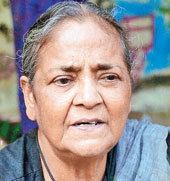Full Name Shanu Mazumdar Role Painter Nationality Indian | Occupation Painter, art educator Siblings Kamal Kumar Majumdar Name Shanu Lahiri | |
 | ||
Born 23 January 1928 ( 1928-01-23 ) Kolkata Known for Public art and graffiti art in Kolkata | ||
Shanu lahiri death pkg 0102
Shanu Lahiri (23 January 1928 – 1 February 2013) was a Bengali painter and art educator. She was one of Kolkata's most prominent female public artists, undertaking extensive graffiti art drives across Kolkata to beautify the city and hide aggressive political sloganeering.
Contents
- Shanu lahiri death pkg 0102
- Subhaprasanna expresses grief over demise of shanu lahiri
- Early life and education
- Career
- Public art projects
- Final years
- Works
- References
Subhaprasanna expresses grief over demise of shanu lahiri
Early life and education
Lahiri was born on 23 January 1928 in Kolkata (then Calcutta) to the Mazumdar family of seven siblings. Her mother, Renukamoyee Mazumdar, though unlettered, practised calligraphy at nights. Lahiri had two older brothers, writer Kamal Kumar Majumdar and artist Nirode Mazumdar. She was a student of the Government College of Art & Craft, Calcutta, from where she graduated in 1951. She was the first student of the college to receive the AIFACS President's Gold Medal. Also in 1951, she studied at the École du Louvre and Académie Julian in Paris on a scholarship.
Career
Lahiri was a painter of the Bengal School of Art. Her first exhibition of paintings took place in 1950. In 1960 she received a scholarship to go to Paris, which was followed by a string of painting exhibitions both in India and abroad. Following her academic career in the West, in the late 1970s, she joined the faculty of the Rabindra Bharati University as a reader in the visual arts department; later she became dean of its faculty of visual arts.
Though artist groups had begun forming across Kolkata by the 1960s, few women found a place or a voice in them. In 1983, upon the request of artist Karuna Saha, Lahiri started the city's first women-only artists group. Called "The Group", it comprised four painters, including Lahiri, Saha, Santosh Rohatgi and Shyamasree Basu, and one sculptor, Meera Mukherjee. The local media dubbed it the Pancha Kanya (Five Girls). The Group's first exhibition was held at the Academy of Fine Arts, Kolkata. In 2008, The Group celebrated its 25th anniversary with an exhibition at the Academy of Fine Arts. Though most of the original members had died by then, it had 17 member artists and a number of guest artists.
Through her art, Lahiri addressed the contemporary realities of society. She was recognised for her individualistic style and became a leading woman artist on Kolkata's contemporary art scene, along with fellow painter Saha.
Public art projects
Lahiri was also involved in public art and graffiti art projects throughout Kolkata. Beginning in the 1980s, she encouraged street children and students to paint on the walls of Kolkata in an effort to beautify the city. The previous decade had been a politically tumultuous one due to the Naxalite movement, which left the city's walls covered with political posters, slogans, and aggressive graffiti. In 1984 Lahiri gathered students of La Martiniere Calcutta to paint over their school wall with colourful art and murals. Gradually this movement caught on, and in coming years Lahiri was involved in similar public art projects in various parts of the city such as Jadu Babu's Bazaar in the Bhowanipore area, the fish market at Sreebhumi, Fort William, and other areas in north and south Calcutta. Inspired by the folk dolls of Bengal, she created a statue of Parama on the Kolkata Bypass.
In the 1980s she moved to the Lake Town neighourhood, where she formed a local group known as bhavana. This group engaged in garbage clean-up drives and also painted neighbourhood walls with graffiti art. Lahiri had her own food stall at the local Durga Puja annual fete, selling kebabs.
Lahiri released her autobiography, Smritir Collage (A Collage of Memories) in 2001. To coincide with the launch she also held an exhibition showcasing the work of her brothers Kamal and Nirode Mazumdar, other members of her Mazumdar clan, nephew Chitrovanu, and niece Oditi.
Final years
Lahiri was active in public art projects into her eighties. In 2010 she organised a project in Hyderabad, bringing together students from various schools, HIV-positive children, and differently abled children, to paint over the walls of the Lakshman Bagh temple as part of Rabindranath Tagore's 150th anniversary celebrations. By 2010, 25 years after she first painted them, some of her graffiti art was still visible, including a 220 feet (67 m) length of wall on the Justice Chandra Madhav Road in Kolkata.
Lahiri died in Kolkata on 1 February 2013. She donated her eyes, and was cremated at Keoratola crematorium. She was survived by her daughter, Damayanti, and her son, Arnab.
